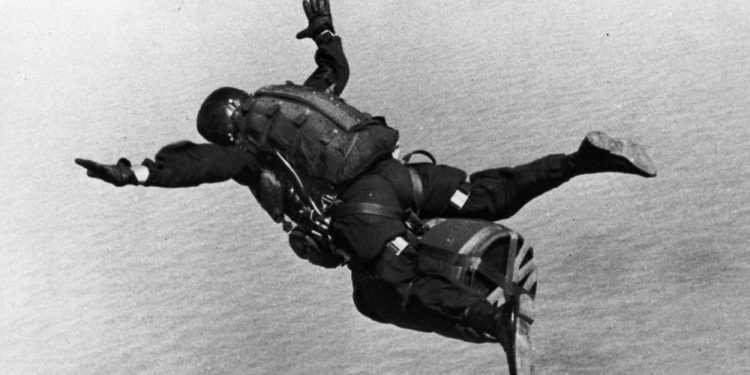Throughout the Cold War, as the nuclear arms race became more frantic, a nuclear confrontation between the U.S. and the Soviet Union remained a major concern.
With intercontinental ballistic missiles, submarine-launched missiles, and air-dropped bombs, both countries had several options when it came to nuclear warfare.
But the atomic bombings of Hiroshima and Nagasaki in the closing days of World War II made clear the destructive capability of nuclear arms and the danger of a full-blown nuclear conflict.
As a result, U.S. strategists sought ways to use nuclear weapons without triggering an all-out nuclear war.
The Tactical Nuclear Option
In the 1950s, the U.S. military came up with the tactical nuclear option, using weapons with a lower yield and range than their strategic counterparts.
These weapons would be used on the battlefield or against a military-related target to gain an operational advantage. For example, the Air Force could drop a tactical nuclear bomb on a Soviet division invading Poland to stop its advance without triggering a disproportionate response — such as a nuclear attack on New York City.
There were two types of tactical nuclear munitions: The Medium Atomic Demolition Munition (MADM) had a medium-yield payload and required several troops to carry it. The Special Atomic Demolition Munition (SADM) had a low-yield payload but could be carried by one soldier.
The order to use tactical nuclear weapons would still have to come from both political and military authorities. SADMs were subject to the same command-and-control procedures as other tactical nuclear weapons and were meant to be used only if there were no other means of creating the desired effect.
Tactical nuclear weapons came in several forms, including artillery shells, gravity bombs, short-range missiles, and even landmines. But perhaps the most interesting iteration was the “backpack nuke,” which was to be carried by Army Special Forces operators.
Green Light Teams
Specially trained Green Berets were assigned to Green Light Teams. Their purpose was to clandestinely deploy in NATO or Warsaw Pact countries and detonate their SADM in a conflict with the Soviets. The Pentagon later included North Korea and Iran on the target list.
Green Light teams’ main targets were tunnels, major bridges, mountain passes, dams, canals, ports, major railroad hubs, oil facilities, water-plant factories, and underground storage or operations facilities.
In other words, SADMs were intended to either slow down the enemy by destroying or significantly altering the landscape or to target the logistical, communications, and operations hubs that are vital to an army, especially during offensive operations.
Green Light teams primarily carried the MK-54 SADM. Nicknamed the “Monkey” or “Pig,” the device weighed almost 60 pounds and could fit in a large rucksack.
In each team, there was a chief operator who was primarily responsible for the activation of the SADM. He and other members of the team held the codes required to activate the bomb.
Like every Green Beret team, Green Light teams were trained in various insertion methods, including parachuting — both static-line and military free-fall — skiing, and combat diving.
Free-falling was probably the most realistic insertion method other than ground infiltration, but doing it with the device was tough.
During parachute insertions, the chief operator seldom got to jump with the device because it had a high probability of injury for the jumper, and the chief operator was key to mission success.
An operator would have to strap the SADM between his legs like a rucksack, but the device would work against him as he tried to stabilize in the air before deploying his parachute. Even in static-line parachuting, when the ripcord is hooked to the plane, there would still be issues.
Paratroopers will release their rucksacks or other heavy cargo attached to them via a line moments before landing to prevent injuries. But the SADM tended to get stuck between the jumper’s feet in the crucial seconds before landing, resulting in several sprained ankles and broken legs.
Everything even closely associated with Green Light teams was top secret, and the seriousness of the mission followed Green Light operators outside work. They were instructed to travel only on U.S. airliners and never to fly above a communist country in case the plane had to make an emergency landing, which could lead to them being held by local authorities.
No One Is Coming for Us
A common thread among successive generations of Green Light teams was their distrust of leadership when it came to their specific mission.
“During training, the instructors had told us we had about 30 minutes to clear the blast radius of the device. We never really believed that,” a retired Special Forces operator who served on a Green Light team told Insider.
“In every other mission, teams would have an extraction plan. We didn’t. It was all up to us to get the hell out of dodge. But that’s not how the Army works. So that’s why we never really believed that we could get out alive in case we had to use one of those things. It was a one-way mission,” the retired Green Beret added.
There were Green Light teams forward-deployed in Europe — even in Berlin — always on standby to launch. Some Green Light teams even sought to forward deploy inside East Germany to be ready in case the Soviets unleashed their military on Western Europe.
Green Light teams also deployed to South Korea at different times and were on standby in case tensions with North Korea turned into war.
With the end of the Cold War, the Green Light teams were deactivated. They were never used in a real-world operation.
This article was written by Stavros Atlamazoglou and originally published on Insider.










COMMENTS
You must become a subscriber or login to view or post comments on this article.